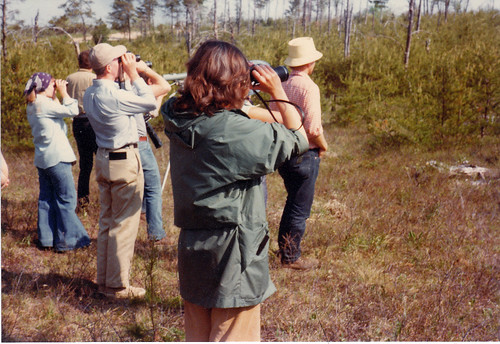 |
| When I was looking at my lifer Kirtland's Warbler on June 6, 1976, there was no such thing as a home computer, much less eBird! |
Way back in 2002, the Cornell Lab of Ornithology and Audubon launched a wonderful and completely free web-based bird-listing program called eBird. When we enter the birds we see, eBird keeps track of our lifelist and our lists for every country, state, and birding location—even our backyard. Not only does this help us keep track for ourselves—it provides valuable data for ornithologists and other birders.
Unfortunately for lackadaisical people like me, eBird’s greatest value for everyone requires us to keep track of the numbers of each species that we see in each location. On a given day of birding, one can easily tally birds in 10 or more locations. For the Sax-Zim Bog alone, eBird lists 78 different locations, and anyone who has actually tried counting chickadees knows it isn’t all that easy, so contributing to eBird can be unwieldy when we just want to chill out looking at birds. And if we forget to jot down where we saw each Gray Jay and Black-capped Chickadee, so just enter it in the Sax-Zim Bog location in general, or St. Louis County, our eBird checklist for the day will be far less valuable for bird population, distribution, and conservation work by scientists.
When it was originally launched, eBird data had to be entered into the computer after we got home, which required birders to maintain a field notebook. I took two ornithology classes during my first couple of years of birding in the 70s, which got me into very good habits as far as keeping a field notebook and keeping track of individuals, but I fell out of those habits long before eBird started.
 |
| My old field notebooks. |
It took a serious adjustment in my mindset to start keeping track of numbers and precise locations again, and even now I’m not nearly as disciplined about this as I used to be—my 2016 New Years resolution is to be far more dedicated to using eBird in the way it was intended.
Fortunately, the more I use eBird, the easier that gets, especially because the eBird team developed and keeps improving a great eBird app for both iPhones and android. Now the moment I arrive at any birding spot, I open the app and press the big start button.
If I select “Choose a nearby hotspot,” it uses my phone’s GPS to find the closest spot to me.
It also knows what time it is. After I choose my location , all I have to do is tap the space in front of any species I see--each time I tap, it adds 1. And if I count 224 Sandhill Cranes, I can touch the species and simply enter the number.
When I’m done, I press Review & Submit, it asks a couple of easy questions, and I’m done.
This year I intend to keep my eBird lists up to date every time I’m out, and from home on days when I keep track of my backyard birds.
I didn’t quite have the hang of eBirding during my Big Year in 2013, so I wasted a lot of opportunities. I did write down most species in field notebooks or checklists, and over the years kept most of my records in a great but now outdated program called Avisys. Little by little I’m entering that old data into eBird. I don’t have most of those locations down to individual spots—often not even the county. And I have virtually no numbers for species on my lists, at least not since I’ve been able to go on exotic birding tours. Fortunately, eBird allows me to enter “historical” data with far less precision—doing that is not nearly as valuable information for research, but the eBird team created this system as a service to birders like me.
I usually work on entering my old data while watching TV with my mother-in-law in the evenings. At this rate, it’ll take years to enter everything, but meanwhile, I’ve made sure my Minnesota list at least shows the number of species I’ve seen in the state. I’m leaving for a California birding trip on Saturday, so I got that list up to date so I’ll know what birds are new for the state.
My next goal is to get my lifelist up to date, which will involve adding birds I’ve seen in Mexico, Guatemala, Costa Rica, Ecuador, and Germany. Then I’ll get the rest of the states up to date, starting with Wisconsin. But meanwhile, even as I go backwards in time in the evenings, I’ll be keeping my day-to-day checklists entered more precisely on the app.
EBird is a great program with enormous value for conservation and research about birds, and it’s free. Anyone who wants to keep track of birds should try it out! Head to ebird.org and get started now!



